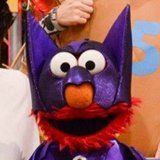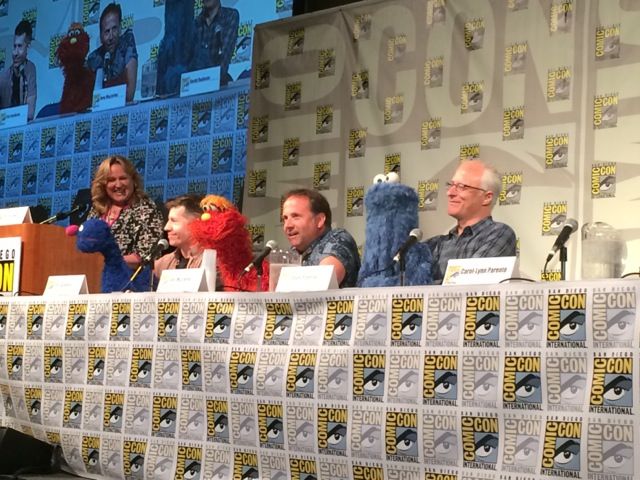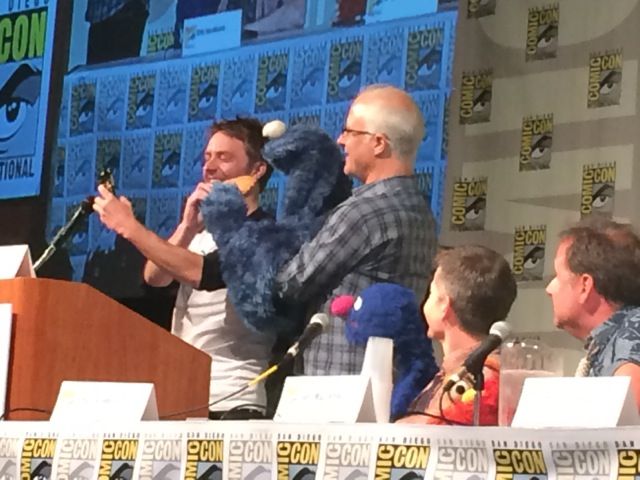The audience attending the “Sesame Street and Pop Culture” panel Sunday at Comic-Con International in San Diego warmed up by singing the theme song to the iconic PBS show along with a couple of puppets. The puppets, Bob and Finn of Duarte.com, were on hand (with their operators) to see the first-ever Comic-Con panel from Sesame Workshop.
Carol-Lynn Parente, executive producer of Sesame Street, introduced herself and thanked the puppets for their opening. “This is my first time at Comic-Con, so I’m a little overwhelmed by day four," she said. "It’s been very exciting, and I couldn’t be happier to be here with you all to celebrate our 45th season. We’re here today to celebrate 45 years of parodying pop culture, that we’re famous for. We brought a brand-new episode that’s going to premiere in Season 45 that I think you will get the parody of. It’s sort of our take on this convention here, with a numerical twist to it. And as a little bonus after that, you’ll see a brand new episode, unseen of 'Cookie’s Crumby Pictures' that parodies Star Wars in a fun way.”
The episode about Numeric Con featured Elmo dressed as The Dark Nine and Leela (actress Nitya Vidyasagar) dressed as Princess Three-a. Filmed in a reality-TV style, the episode followed the pair as they planned a list of activities to do at Numeric Con.
As the story developed, Elmo encountered a variety of pop-culture figures who were parodied to reflect a numerical value. Elmo was able to demonstrate numeracy with Doctor Two by counting aliens, including Daleks that screeched “Enumerate!” Cookie Monster appeared dressed as In-Three-Ana Jones and got a big laugh from the audience when he opened the Ark to reveal something other than cookies. One of Sesame Street’s strengths became evident as the story progressed: It was teaching mathematical skills such as subtraction and counting, but it was also gently educating its viewers about convention culture. They learned about sneak peeks, taking photos with heroes, and getting autographs.
The resolution to the story involved a new Muppet character arriving to save the day. It included a Star Trek reference that was so spot on, that it earned a loud cheer from the audience. Meanwhile, the “Cookie’s Crumby Pictures” segment “Star S’Mores” focused on Cookie Monster as Flan Solo learning self-control strategies to avoid eating his co-pilot Chewy, a puppet cookie. Along the way, he meets characters such as Only One Canoli, Groda and Dark Baker.
“So what do we think? Good?” asked Parente. After another round of cheering, she said “OK. I’m coming here every year to premiere my film. So let’s get this panel started and make it the best convention ever!”
Eric Jacobson, performer of the characters Grover and Bert, took to the stage with Grover. Joey Mazzarino, head writer and director of the Numeric Con episode followed, with Murray Monster. David Rodman was the last performer introduced, and took to the stage with Cookie Monster.
The performers greeted the audience in character. Cookie Monster started with a long, gravelly “Hi.” Grover said “Hello, Everybody!” and Murray said “Thank you all for coming so early on a Sunday! You guys are awesome!” Parente then introduced moderator Chris Hardwick, founder of The Nerdist and “host of a show that’s maybe a little late for our target audience, @midnight.”
Hardwick complimented the Sesame Street team on the screened episodes, and then addressed Parente, saying that a strength of the show is its pop-cultural appeal to both kids and adults. “You know, it’s been around, this notion of writing on two levels for adults and kids as part of the very first season of Sesame Street,” Parente said. “And it’s all by design, because most important is our educational messages that we’re trying to get through. The only way you can teach is to reach, and we know from studies that the kids get more out of it when there’s a parent or caregiver watching with the kids.”
“Often, the kids don’t know who the celebrities are that come on or don’t get the parodies, but when the adults are watching with them, that’s part of the whole design,” she sadded.
When Hardwick asked about the show's response to the digital age, Parente replied, “I think the secret of Sesame Street is that we’ve evolved over time. So the show looks very different than it did, and we’re on just about any platform that’s out there. We have content there, and the beautiful thing is that the ... the ...” She broke off as Hardwick took a selfie with Grover. “It’s hard to be a straight person for the puppets,” she laughed. “You get to have interaction. Like this!” Grover said “The digital age is happening as we speak.”
Hardwick then addressed Grover: “I love all the characters on Sesame Street, but Grover, you were the character I identified with the most, because you’re sweet and vulnerable, but positive and upbeat. And then there’s Super Grover ...” The other puppets jumped in. “Are they the same person?” Murray demanded. “Wait! You know Super Grover?” Cookie Monster asked.
“I’ve never seen them in the same room together,” Hardwick replied. Cookie Monster pondered this, crying, “Wait a minute! Nooooooo!” he yelled. But Grover interjected, “Come on, we are all superheroes here. Are we not?”
Hardwick continue,d “Grover, how do stay so positive. Obviously the world be a challenging place. Where do you dig down deep to pull out the strength that you have?”
Grover began to look around the podium for his strength. “Looks like it got left back at the hotel room. I do not know," he said. "I was just born this way. I was just born with a positive attitude, and I believe that everybody, if you try and try and try ... well, you might fail, but there is a chance that you could succeed!”
On the real-life side of the panel, the moderator asked Jacobson what has kept him with the show for 20 years.
“I think first and foremost, I was a fan of Sesame Street and Jim Henson and the Muppets,” he responded. “When I was in film school, Jim Henson passed away, and that just sent shivers down my spine. I realized right then and there how much this man had meant to me growing up. I had to do something to help continue his legacy. I didn’t know what exactly at the time, but I figured it out pretty quickly because by the time I was out of college, I was working on Sesame Street.”
“It’s a huge honor to be continuing this legacy," Jacobson continued. "Frank Oz is a genius. He created this character and Cookie Monster. My hat’s off to him and all of Jim’s colleagues. They are the reason why I’m here sitting at this table in front of all you guys. If it had not been for them, I would not be here.”
Mazzarino's path to the show took a different form. “I was an actor,” he explained. “I was studying acting at Fordham, and a woman came in to teach comedy improv by the name of Camille Kampouris, and she was a puppeteer. Her name was Camille Banora at the time, and she said Jim was going to be there. I was working on a theater piece for her friend and she said, ‘Do you want to meet Jim?’ and I said ‘Yeah!’
“I really had no idea about puppetry or anything about it. I went to the set of Sesame Street and I met Jim and I babbled like an idiot, but it was seeing Richard Hunt and Jerry Nelson, who have since passed as well ... give them a round of applause! They did everything. They seriously did every character you love that wasn’t Frank and Jim on The Muppet Show and Sesame Street. They were men of thousands of voices. I watched them and it was Richard in particular who did a butler that day. He made the crew crack up and I was like ‘That’s the guy. I want to be that guy.’”
The puppet characters got their moments to shine in terms of their jobs on the show, from Cookie Monster's demonstrating his ability to resist the urge to eat cookies (or attempting to) to Murray describing his role as "Muppet on the street" for the series.
“I actually work around the streets of New York,” Murray explained. “I interview real people on the streets of New York, which can be a dangerous job. I meet kids and people and adults and I basically harass them on the streets until they talk to me on camera ... My favorite thing is I go to a lot of schools, and I have a little lamb. My name is Murray and it’s ‘Murray had a little lamb.’ I love to see kids who are awesome at different things. Like to see kids who are amazing gymnasts, or are amazing dancers: that’s my favorite thing is seeing kids who are awesome at stuff."
Hardwick then opened the panel up for audience questions, and a line of people quickly formed at the microphone. The puppeteers from Duarte.com were first. “We were wondering, Grover, Murray and Cookie, what are the big stories that inspire you to make such great ones up there?” one of the puppeteers asked.
Grover said, “I am very much inspired by Superman. It is why I don the cape every once in a while. What about you, Murray?” Murray started to answer, “I am inspired by real human stories ...” and then Mazzarino shifted to his own voice. “I’m going to speak as myself because this is actually real. I met this kid through a friend who’s a puppeteer. He’s 10 years old and he does this thing called The Mo Show. Check it out on YouTube. This kid is awesome. So when we had this opportunity to interview kids and what they do and what’s special about them, I was like, ‘You gotta come out here and do it.’ And he brought his puppets. I love to be able to do that. To see real kids’ stories.” Cookie Monster answered, “Me been lucky enough to do the 'Crumby Pictures Stories.' So all those parodies are a blast!”
An audience member named Samantha said, “I wanted to know how your writers’ room works? How you determine what you’re going to cover and when the right time to broach more controversial issues is?”
Mazzarino replied, “The staff has outreach that deals with some really heavy issues that I don’t write for. One of our writers, Chrissie Ferrarro deals with like incarceration, military families and the issues they deal with. That’s a separate group, but they really do go out and find out what these kids’ need. Our show is all about kids’ needs, whether its the alphabet and what you learn and more specialized.”
Asked who from the show they'd camp out with for Hall H, Murray answered, “I would camp out with Snuffy in case it’s cold. I would cut him open like a tauntaun.” The audience erupted in shocked laughter. “It’s a puppet-eat-puppet world, people!” he said. Grover answered, “I would hang out with Murray because he would keep me in stitches.”
Cookie Monster considered a moment before answering ,“Herbert Birdsfoot. Me going way back to the early ‘70s.” Hardwick answered that he would choose Oscar the Grouch because he thinks that he’s secretly a Time Lord from Doctor Who. “The trash can is a chameleon circuit TARDIS,” he joked.
One questioner wondered, “How do you as artists feel about the role that Sesame Street plays in the debate over public funding for the arts? Specifically when you have presidential candidates who say they want to fire Big Bird?” Murray answered, “I’ll let you handle that one, Carol-Lynn! That is above my pay grade!”
Parente said, “What we’re really proud of is that we are still a PBS show that is carried on the most, widest [number of] stations. And we’re a show that has no commercials and is on these publicly funded channels. I think when you’re as beloved as we are, you get used often as platforms for lots of things. Our job is to remain neutral and let them ... you know. You can’t help but be flattered that they’re using you for whatever interest.”
An audience member named Jodi asked what type of future parodies would be made. Mazzarino spoke up as Murray, saying, “Well, we have a possible Game of Thrones parody, a possible Age of Ultron parody, and we possibly have a House of Cards parody. I never know what I’m allowed to say. Sometimes I say something and four executives look at me with a very stern face!”
“I grew up as a trans kid,” said the final audience member. “Is there any possibility for a trans-kid character or teaching of acceptance?”
Parente answered, “What’s important about Sesame Street, and what I love so much about it, is that it’s a show that’s embraced diversity of all kinds. The show was founded on a diverse neighborhood that includes humans and grouches and monsters and snuffleupaguses. So what’s important for us is acceptance and that curriculum of accepting differences in others.”



